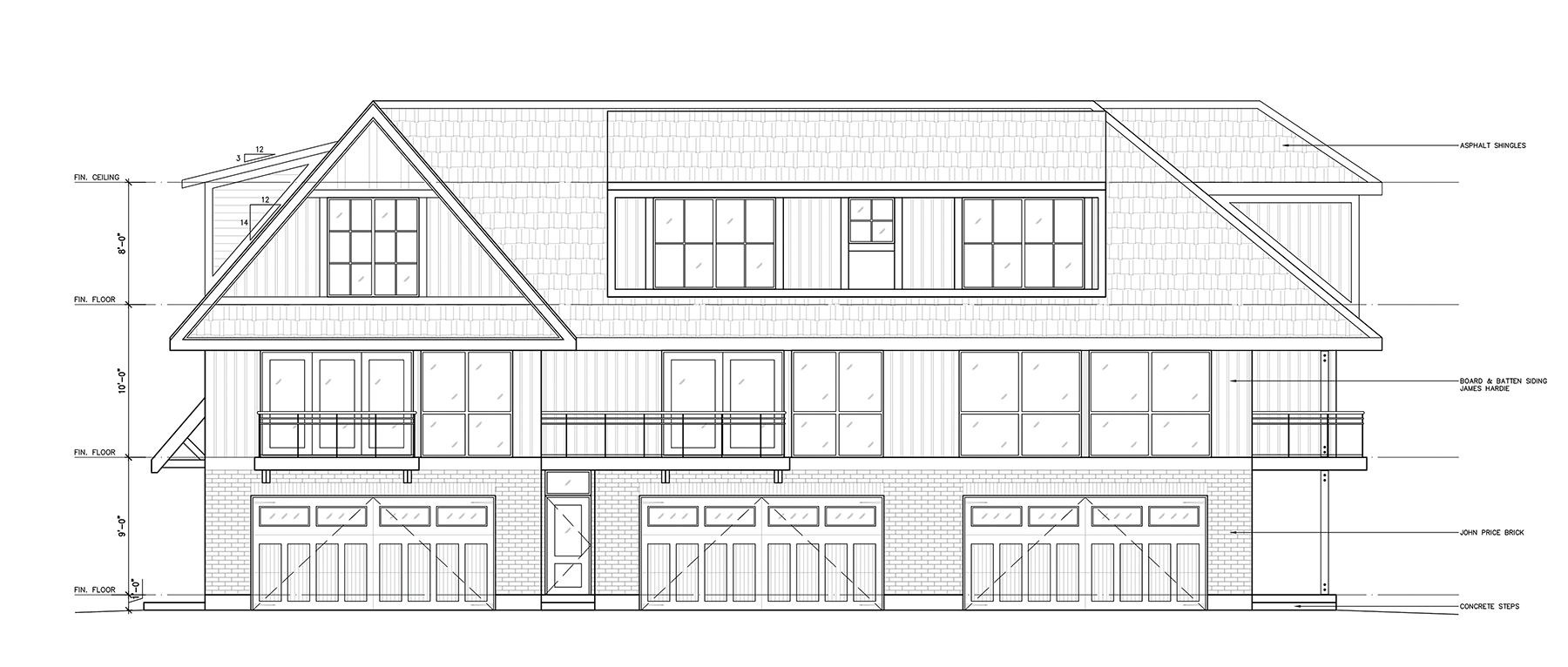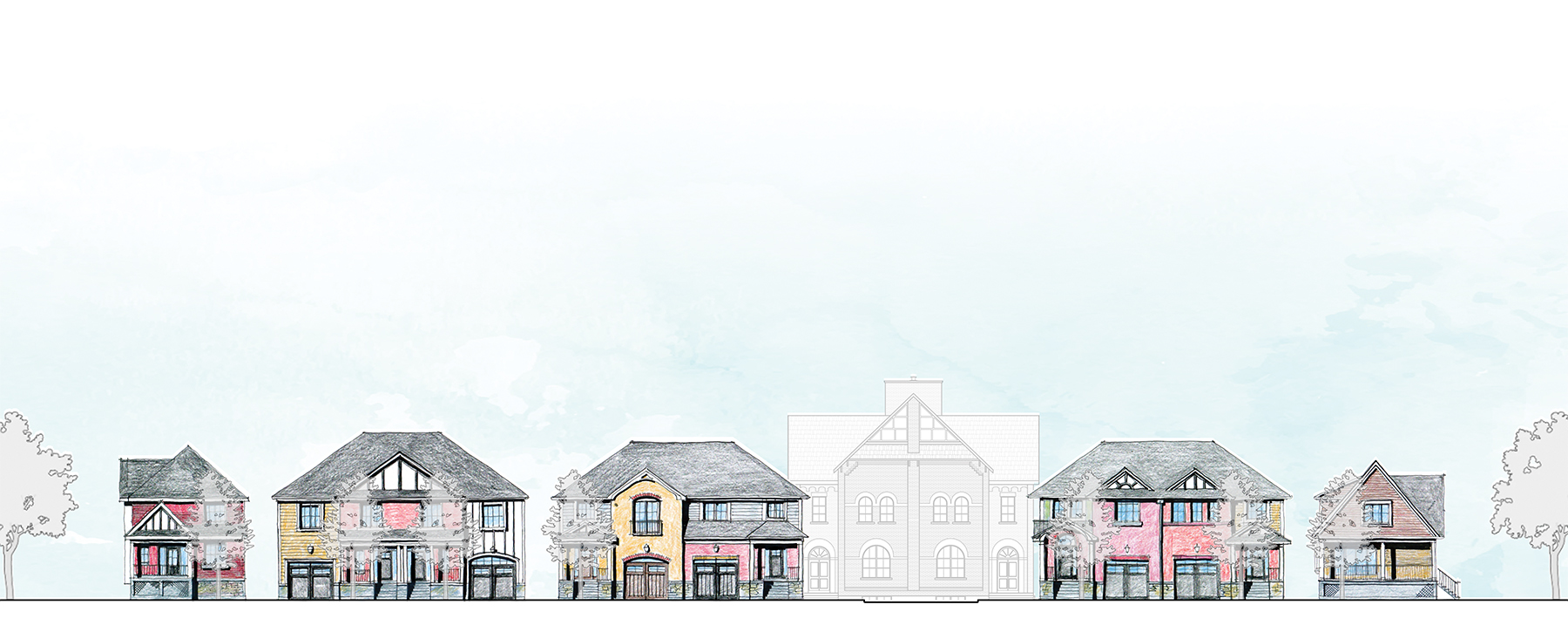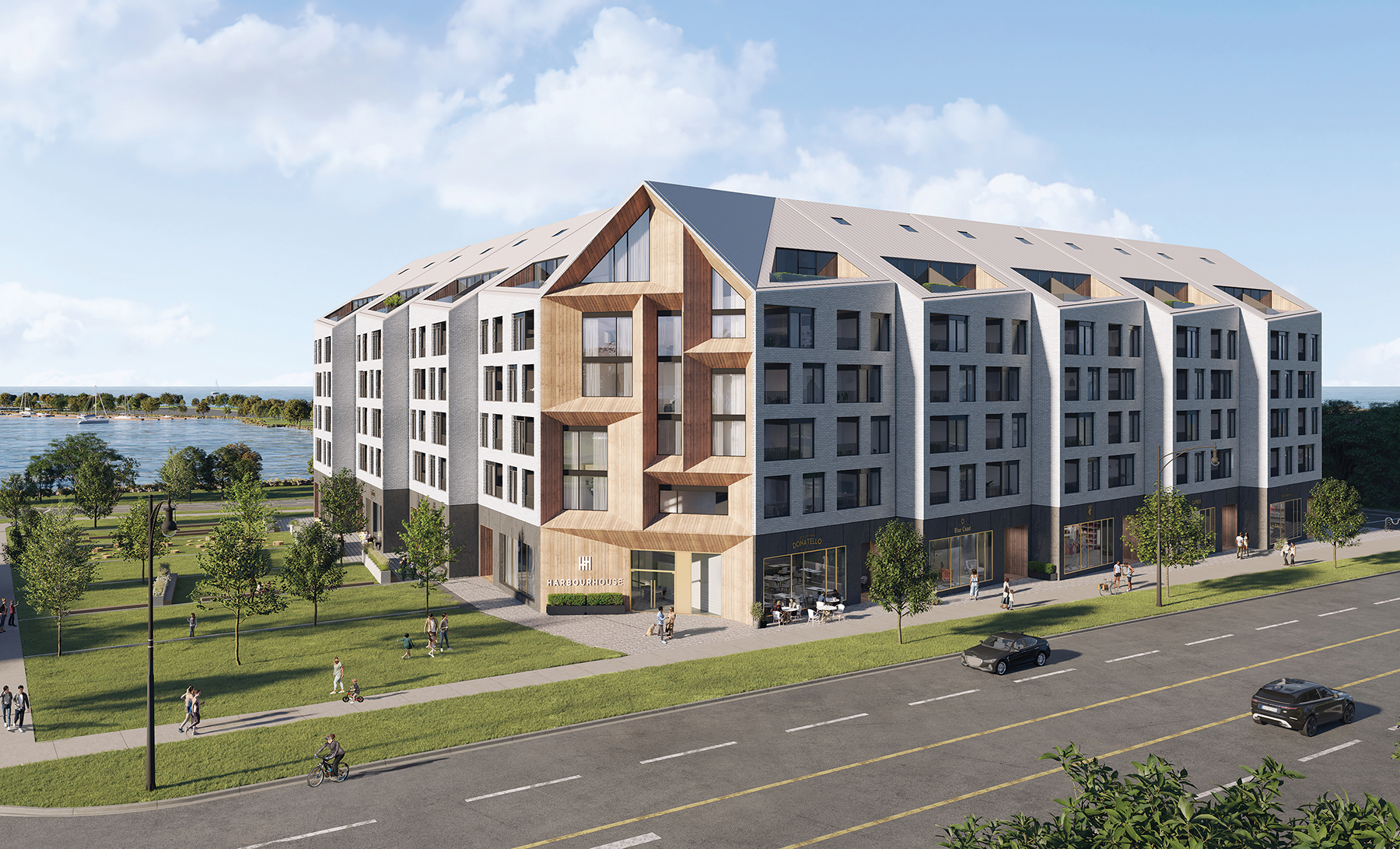A dynamic development picture
The cost of housing continues to climb in Southern Georgian Bay, fuelled by a combination of unstoppable market demand and new interest in our region during COVID-19. Local developers and municipalities are responding by offering fewer detached homes and more affordable, semi-detached, townhome and apartment units in their projects, appealing to a wider range of demographics and design tastes. Meanwhile, local municipalities are coming up with ways to house the region’s middle-income earners.
by Marc Huminilowycz

With supply of resale homes at an all-time low in Southern Georgian Bay, developers are scrambling to bring new homes to market while demand is hot – in fact, it’s so hot, many residential projects are selling out with little or no marketing, before a shovel even turns over the first clod of earth.
In a recent article in Ontario Home Builder Magazine, the voice of Ontario’s development and building industries, Robert Hogue, senior economist for RBC Economics, observed: “Smaller markets across the board in Southern Ontario, such as Kitchener-Waterloo, London, Guelph, Barrie, Collingwood and Southern Georgian Bay, are super strong on a year-to-year basis. While some people are buying secondary homes in what are considered vacation destinations, skyrocketing school registrations indicate that some families are making a permanent move.”
Hogue noted some of the reasons for the rush to buy in places like Southern Georgian Bay: “Many organizations will be more flexible about employees working remotely, and that’s helping to drive many out of the downtown core. It’s opened a lot of new frontiers for those no longer tied to a GTA office, as they seek larger houses to accommodate working from home and family living, more greenspace, and the ability to safely distance from others in less dense environments.”
Hogue noted some of the reasons for the rush to buy in places like Southern Georgian Bay: “Many organizations will be more flexible about employees working remotely, and that’s helping to drive many out of the downtown core. It’s opened a lot of new frontiers for those no longer tied to a GTA office, as they seek larger houses to accommodate working from home and family living, more greenspace, and the ability to safely distance from others in less dense environments.”
Sal Guatieri, director and senior economist for BMO Financial Group, added, “People are moving out of Toronto to the Greater Golden Horseshoe and beyond. That’s where you’re seeing the biggest price increases, of 20 per cent or more year to year. It’s a clear trend, with many of the sales shifting away from larger metropolitan regions to suburban and rural regions.”
Across our area, home sales are indeed strong, prices are rising accordingly, and it’s more important than ever to be ‘in the know’ about what’s coming down the pike if you’re looking to buy. Here’s a look at some of the key residential developments coming on stream in 2021 across Southern Georgian Bay.

According to developer Tony DeRose of Pacific Homes, which will be building approximately half of these homes, units will range from townhomes in the 1,300- to 1,700-square-foot range starting in the mid $400,000s, to single detached homes 1,400 to 2,600 square feet starting in the mid $600,000s.
“Site servicing is scheduled for this spring, construction will begin in the fall, and we hope to have occupancy next spring,” said DeRose. “In the meantime, we’re finalizing negotiations with the regional public and Catholic school boards to build a high school and three elementary schools on the property when needed.” Needless to say, the project’s primary buyers will be young couples and growing families, but DeRose doesn’t rule out retirees. “Our demographic is everybody. They’re coming from Barrie, the GTA and even the Greater Golden Horseshoe, looking for affordability and lifestyle.”
With current projects totalling more than 3,700 residential units and more in the queue, Wasaga’s planning department is busier than ever. “Our workload and deliverables have been crazy during COVID, with sales much higher than anticipated,” said Director of Planning and Development Doug Herron. “Twenty years ago, 90 per cent of our new residential properties were single detached. In 2020, 50 per cent were singles and townhomes. This shows that our residential diversification policies are working, indicating a trend away from singles to medium-density towns and high-density apartments. Our overall strategy involves changing our housing prices and strengthening our services. As we grow to be a complete community with more services, we are attracting more young families, which energizes the community.”

“We have around 4,000 units in draft plan and a couple of hundred registered or pending registration this year.”
Mara Burton, Clearview

Burton said that much of the new housing in Clearview, such as Aspen Ridge, is appealing to younger buyers with a variety of housing types. One new development in Creemore, The Brix from MDM Developments, has its sights set on exactly that demographic. The “luxury boutique” project situated steps to downtown, will consist of two three-storey buildings containing thirty-six units in each building, ranging from 1,000 to 1,200 square feet and starting from $500,000.
“The Brix will offer nice, high-end designs that will appeal to a wide range of demographics, but primarily millennials and Gen Xers from Collingwood, Barrie and the GTA,” said MDM Development Manager Joe Saso. “Why did we choose Creemore? We pick markets with great potential and appeal, especially now during COVID. The whole Clearview municipality has a good vibe, with lots of outdoor lifestyle options combined with vibrant downtown areas.”
North of Clearview in the Town of Collingwood, numerous residential units are in queue at various stages of approval. According to Senior Planner Mark Bryan, current building activity is focused on build-outs of existing subdivisions such as Indigo Estates, Summitview, Blue Fairways and the Riverside midrise block on Peel Street.
“In 2020, Collingwood issued 448 building permits for new residential developments, consisting of 141 single detached homes, 10 semis, 99 townhomes and 198 apartments,” said Bryan. “There is considerable variation from year to year in the types of dwellings, but over the past decade, there has been a shift away from lower density projects to higher density such as townhouses and apartments.”
As to buyer demographics, Bryan noted steady sales from retirees, with anecdotal evidence of younger age groups and families choosing to make Collingwood their home. “Changing demographics will likely be forthcoming from the May 2021 census,” he said.
With that in mind, two new development proposals will offer high-density housing options in the heart of town. The Victoria Annex property, containing a 19th century schoolhouse on Maple Street, has recently received another in a line of proposals over two decades from at least five developers. The latest, from Maple Street Limited/Georgian Communities, proposes 19 residential units including four single detached homes, 10 semi-detached units, three townhouses and two units in the schoolhouse.
Another project, on the corner of Huron Street and Heritage Drive is being proposed by Streetcar Developments in Toronto, a company that specializes in midrise residential infill projects “inspired by our surroundings” in trendy inner-city neighbourhoods. Harbour House Collingwood will be a six-storey commercial/residential building with approximately 3,645 square feet of ground floor commercial space and 130 condominium apartment units. At press time, not many other details were available, except that the project describes itself as “Modern Luxury in Downtown Collingwood” with occupancy in 2023.


“I’m not sure if it’s a COVID thing or just a continued trend, but we’re seeing a shift in marketing from developers towards a broader demographic beyond retirees.”
Nathan Westendorp, The Blue Mountains
According to Nathan Westendorp, Director of Planning and Development Services for The Town of The Blue Mountains, there are 3,000 to 4,000 new residential units in various stages in the municipality’s pipeline, with the number of building permits doubling in the past two years. “I’m not sure if it’s a COVID thing or just a continued trend, but we’re seeing a shift in marketing from developers towards a broader demographic beyond retirees,” he said. “Our community is desirable to all ages, with new developments offering a wide cross-section of home types and an increase in multi-unit residences.”
One example of this diversity is a new application for a property known as Home Farm – several parcels of land on Concession 2, with road access from Grey Road 19, located across from The Orchard at Craigleith development. The proposal, from MacPherson Builders, is for a subdivision containing 85 single detached homes, 60 semi-detached homes, and 132 townhouses, for a total of 277 units.
“Variety and diversity in housing is not a bad thing, so long as we make sure that new projects fit in with the character of the town and are done in a sustainable way from an environmental and social perspective,” said Westendorp. “Our goal is to enhance new growth while optimizing our infrastructure – in other words, use what we have before expanding.” To that end, The Blue Mountains has improved its development application processes and communications to enhance the efficiency, consistency and pace of project approvals.
With the highest average cost of a home (new and resale) in Southern Georgian Bay and prices continuing to rise in The Blue Mountains, the municipality is faced with an elephant in the room – affordability. Acknowledging that its home prices are beyond the reach of even middle-income earners, the town is going above and beyond to address the issue.
“The town has identified attainable housing as a municipal priority. We can’t conquer this on our own, but we’re playing a leading role,” said Westendorp. On January 11, The Blue Mountains Council passed a new Community Improvement Plan titled “Housing Within Reach CIP,” containing strategies and incentives geared to the creation of attainable housing. The plan includes programs to offset planning application and building fees, and development charges for attainable units; reduce financial barriers to investments for renovating and repairing existing dwellings or converting spaces into attainable units; and help landowners mitigate the costs of increased tax assessments due to their attainable housing projects by helping them secure project financing.
The town was also instrumental in forming The Blue Mountains Attainable Housing Corporation, which acquired the former site of Foodland on Highway 26 for the construction of a five-storey attainable housing apartment complex. “The board is now refining the basic elements of the structure, setting project objectives, and conducting technical studies to do with traffic, air quality and noise,” Westendorp explains. “Once the studies are done, town staff will embark on the planning process, including public consultation on the building’s height, design and number of units. The timing? Sooner than later, we hope.”
To the west of The Blue Mountains in the Municipality of Meaford, projects totalling approximately 2,500 residential development units are in the works, according to CAO Rob Armstrong. These include the massive, 800 to 1,000-unit subdivision on 400 acres of land west of Christie Beach Rd. from Parkbridge Lifestyle Communities, a 250-unit attainable housing apartment, and a five-storey life-lease condominium on the site of the old Canadian Legion.
One notable development proposal that the municipality is anticipating at the time of this writing involves the former Stanley Knight site on the waterfront east of Meaford Harbour. The mixed-use redevelopment plan, presented at a virtual open house January 27 by Guelph developer Skydevco (a division of the Skyline Group of Companies), revealed a considerable amount of detail.
In the middle of the triangular-shaped site will sit a five-storey, 120-unit apartment building. To the north, on the waterfront (retained by the municipality) will be 78 freehold townhouse units and a five-storey hotel containing a spa and gym. (Skydevco is currently in negotiations with an interested hotelier on this.) The south end will contain another 14 townhomes. The entire site will feature an improved sidewalk, tree-lined boulevards, a dog run, benches and an environmentally sensitive public green space on the waterfront connected to street access and a proposed waterfront boardwalk.
“Meaford is in desperate need of affordable homes, especially rentals,” said Skydevco Vice President Carrie Lamarche during the presentation. “Our townhomes will vary in price, but they will be in line with market rates. For our apartments, we’re focusing on two-bedroom, two-bathroom units approximately 700 to 800 square feet in size. With underground and outdoor parking, they will be liveable, with walkability and green spaces throughout.” Skydevco is hoping for a final council decision on their project this October, and occupancy of their first building in 2023.
South of Meaford, in the mostly rural municipality of Grey Highlands, only a handful of residential developments are currently in the works, primarily in the community of Markdale. However, major development activity is set to take place soon.
Last October, Grey Highlands announced a joint venture partnership with the new owners of the Talisman Resort property, which has, over the past five years, been lovingly brought back from the brink of decay due to abandonment by its previous owners. According to a Grey Highlands news release, the municipality and Talisman owners will be working toward potential development of both the Talisman property and the adjacent municipally owned lands in the Beaver Valley and Markdale areas.
Grey Highlands is currently planning community visioning sessions to seek public input on future opportunities for municipally owned properties in the area. The strategic development opportunities of the project are being supported by Grey County’s economic development team and their investment consultants, thinkCOMPASS Consulting & Marketing, a company that helps businesses and governments strategize and execute plans for growth.
“Grey Highlands and the surrounding areas are the envy of many Ontario communities, and represent enormous opportunities,” said Talisman owner Brian Ellis in the news release. “We are committed to establishing a strong and productive working relationship with council and the community to advance our mutual interest in the future vision and development of Talisman and the Beaver Valley region.”
“There’s already a lot of interest from developers and investors,” said Ellis in an interview with this writer, noting an abundance of land available for development on the Talisman site itself and surrounding it – approximately 300 acres in total. Meanwhile, millions of dollars have been invested over the past five years in the restoration and renovation of the Talisman Resort’s three main buildings.
“Our main lodge has finally been brought up to building code,” Ellis explains. “There was virtually no insulation in the walls. Almost all the plumbing, wiring, roof and soundproofing had to be redone, and new exterior stucco and new windows have been installed.” He is now awaiting financing to complete renovations on the main lodge and the adjacent building – hopefully in the next six months. There are also plans in the works to create a new hotel lobby connecting the two buildings, which would be finished in sixteen months. Once complete, the resort, named Talisman Mountain Springs, will have 150 suites, restaurants and spa facilities catering to adult guests.
In the meantime, work is under way on a Nordic spa in the resort’s former base lodge building, which will house 18 to 20 treatment rooms, a saltwater cave, and a restaurant/bar area. Outdoors, guests will be able to choose from three spa experiences: a Social Zone with hot tubs and waterfalls for quiet chats; a quieter Whisper Zone featuring pools and waterfalls, and a “no talking” Zen Zone with an east Asian feel. Talisman currently has a deal in progress with Hilton Hotels to operate the facility as a boutique hotel when it is complete. According to Ellis, Hilton will bring to Talisman its name recognition, booking and administration options, and over 70 million loyal members worldwide.
“Our partnership with the Municipality of Grey Highlands is a unique collaboration that brings many benefits to both parties. They’ve been absolutely phenomenal,” said Ellis. “We will be working hand in hand with them to move everything forward and establish the region as a health and wellness destination.”
The development picture continues to evolve as the market demand for housing shows no signs of letting up in Southern Georgian Bay. No longer primarily catering to retirees and empty-nesters, regional developers are stepping up to meet the needs and wants of a broader demographic with unique design tastes, home style preferences and budgets. At the same time, municipalities in our region are coming up with housing strategies to address changing demographics and growing concerns about affordability. ❧












